| |
Cryptocoryne usteriana Engler |
At this moment (end 2001), there are four slight different plants known as Cryptocoryne
usteriana. First the plant collected by Josef Bogner on Guimaras (Philippines) in1983
(Bogner 1644). This one is widespread in Europe. Second, a plant from Russia, shipped by
Alexei Bednii, from an unknown origin. Third, a plant brought by Claus Christensen,
originating from or near Cebu. Fourth, plants collected by Morco in Guimaras (Philippines)
and frequently shipped to Europe.The plants are referred here as "Bogner, Bednii,
Christensen and Morco" for ease. All plants are very easy to cultivate and are good
aquarium plants.
Click on the picture to get the full image (ca. 50 kB) |
 |
Cryptocoryne usteriana (a Bogner
1644 descendant) is cultivated emersed under high humidity and artificial light. The
bullated leaves are in respect to the other plants rather narrow (5 cm). The lower side of
the leaves may be in part purple.
coll. Bogner1644, cult. B580 |
|
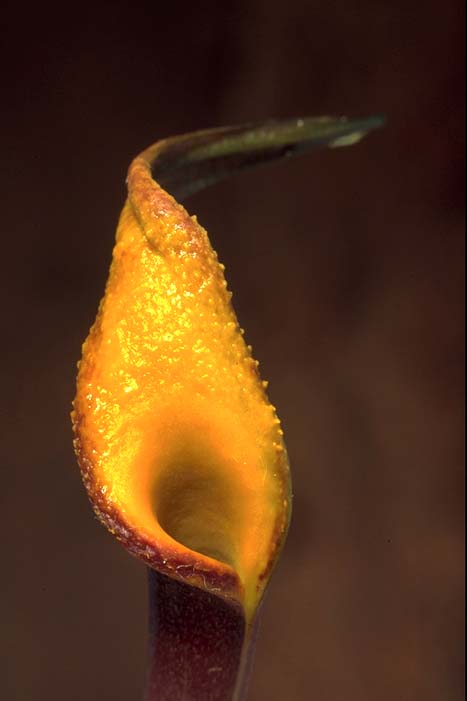 |
The limb of the spathe is deep yellow with at
most some brownish glow near the edge, the top is narrowed and a bit twisted. The surface
is slight uneven, the border have some small bulges. There is no collar.The throat has the
same color as the limb and has, as usual, a smooth texture.
coll. Bogner1644, cult. B580
|
|
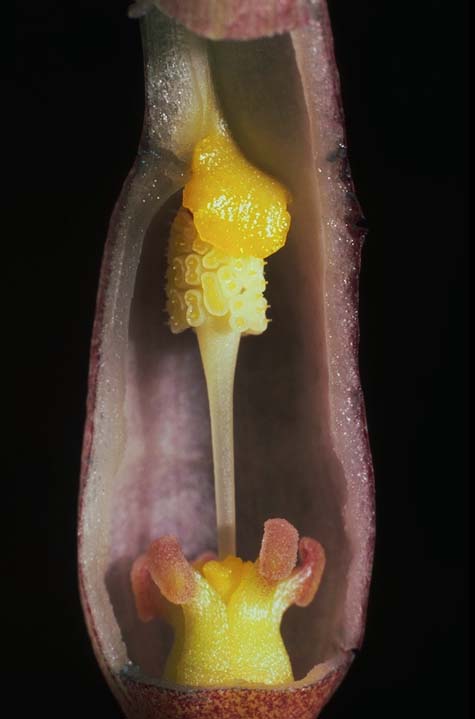 |
A length cut through the kettle. Note the yellow
cap above the male flowers. The lower half of the kettle is somewhat broadened. This is
not always seen in C. usteriana. The naked part of the spadix is mostly slight
longer than seen in this picture. Note the pronounced stigma's.
coll. Bogner1644, cult. B580 |
|
 |
Herbarium sheet of C. usteriana. Bogner
collected this plant (only 5 cm!) on Guimaras in 1983 (Bogner 1644) and he was in doubt if
he had collected C. pygmaea. It was a great surprise that these plants developed
bullated leaves and have a yellow limb of the spathe (see top row).
coll. Bogner1644 |
|
| |
|
|
|
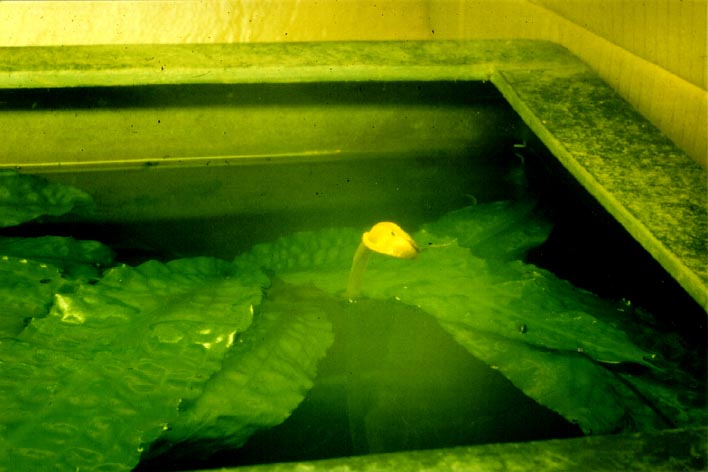 |
In the 1990's there was a report from Russia on
a new giant, broad leafed C. usteriana. It was said that the plant originates
from Wladiwostok, where it was brought by a sailor (from Vietnam??). The leaves are bright
green on both sides (up to 10 cm wide), the limb of the spathe bright yellow.
coll. hort., cult. Kovalev
photo Kovalev |
|
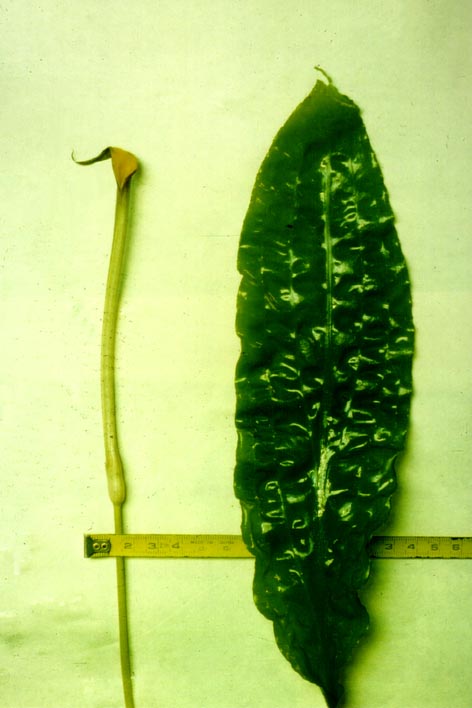 |
A picture of both the spathe and a leaf of the
Russian C. usteriana. Thanks to Alexei Bednii, we cultivate this plant in the
Netherlands. Under equal conditions, this plant may develop a partly reddish lower side of
the leaves.
coll. hort., cult. Kovalev
photo Kovalev
|
|
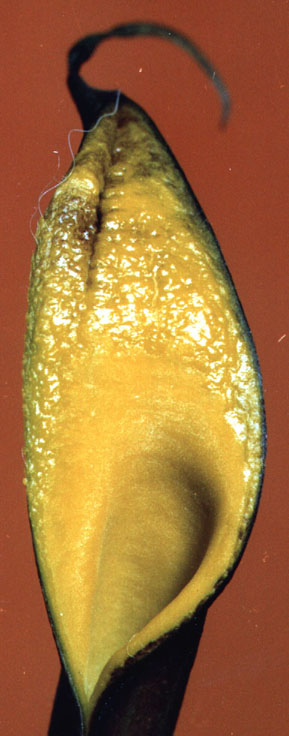 |
The limb of the spathe may have some brownish
hue. At best this form is color like the Bogner plant, but is about twice as big.
coll. hort., cult. Bednii
photo Bednii |
|
 |
The kettle has a broadened lower part, which is
not unusual in C. usteriana. Remarkable for this inflorescence is the circle with
eight female flowers, what is seldom seen in Cryptocoryne, but it is not a
typical character.
coll. hort., cult. Bednii
photo Bednii |
|
| |
|
|
|
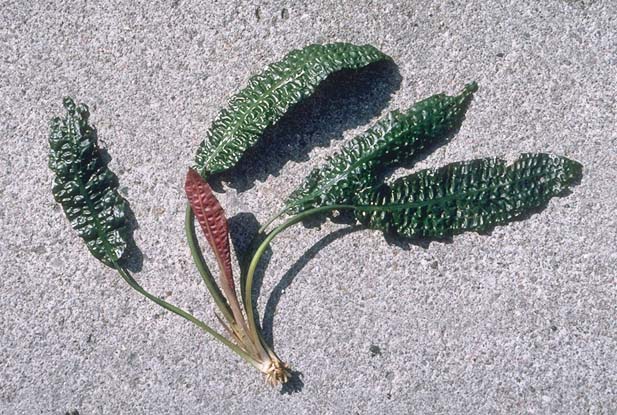 |
In 1994, Claus Christensen (Tropica, Denmark)
got a new Cryptocoryne usteriana from the Philippines. 'It was said' the plant
was collected in or near Cebu. In cultivation the plant is less bullate and may develop
brownish leaves with a more or less red lower side.
coll. hort. cult, NJ 2116
photo Jacobsen |
|
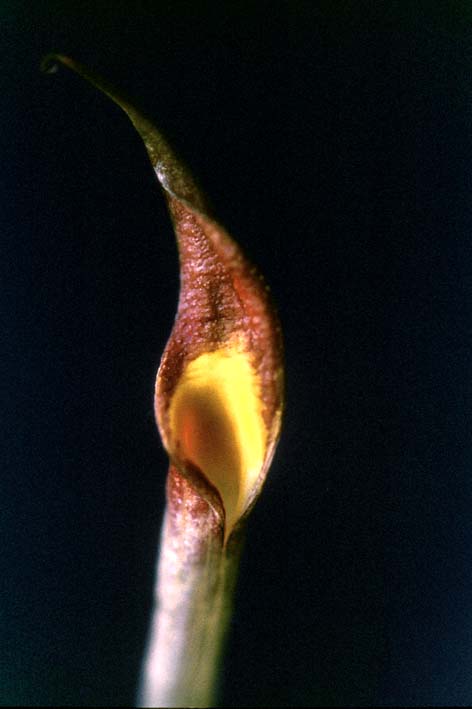 |
This C. usteriana flowered at
Copenhagen. with the limb of the spathe strongly brownish, but depending on conditions it
may be slight brown (see below).
coll. hort. cult, NJ 2116
photo Jacobsen
|
|
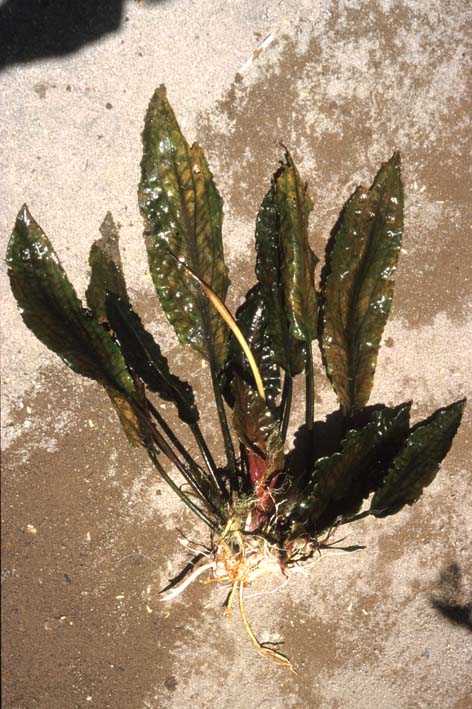 |
Inspired by the reports on the Bogner plant,
Morco found another C. usteriana in Guimaras. This one has the upper side of the
leaves dark green/bronze/brown colored with mostly a deep red lower side. This picture is
made at his plant farm in Luzon.
coll. & cult. Morco |
|
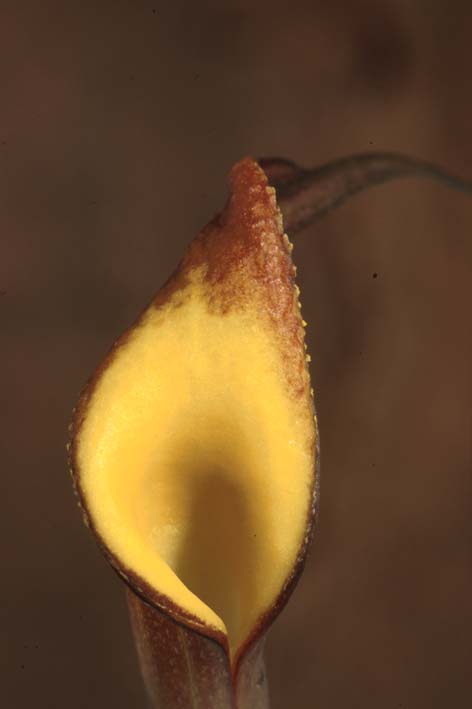 |
The limb of the spathe of the 'Morco' plant is
more or less brownish, like the Christensen plant.
coll.Morco, cult. B756 |
|
| |
|
|
|
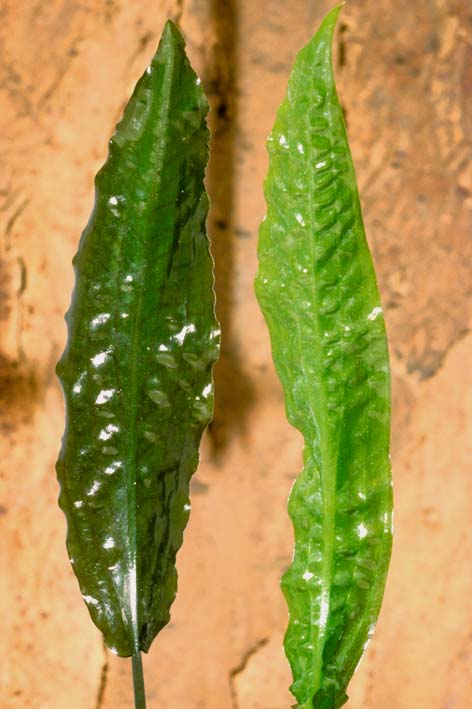 |
Leaves of young plants, left the 'Morco' plant,
at right the 'Bogner' plant.
cult. B756 (left) and B580 (right) |
|
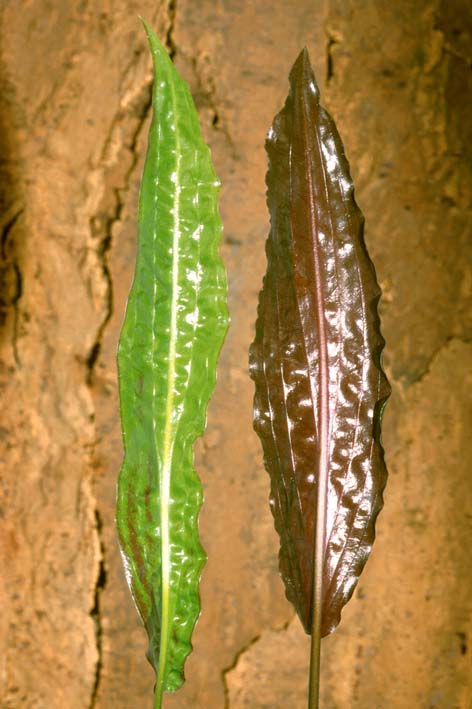 |
Upside down, left the 'Bogner' plant, at
right the 'Morco' plant.
cult. B580 (left) and B756 (right)
|
|
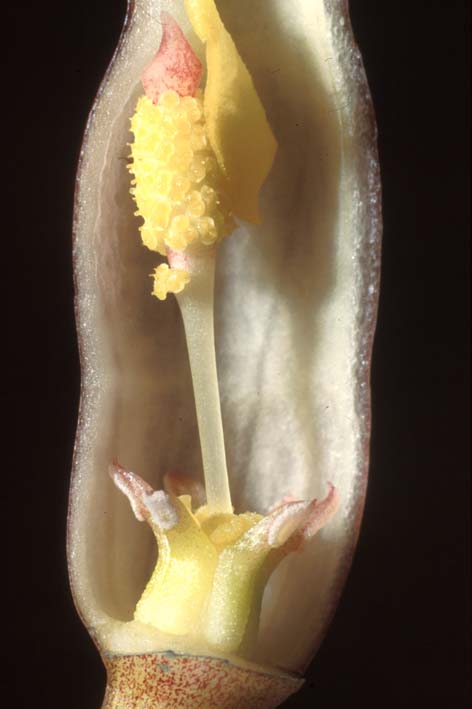 |
An opened lower part of the inflorescence (the
kettle) of the 'Morco' plant.
coll.Morco, cult. B756 |
|
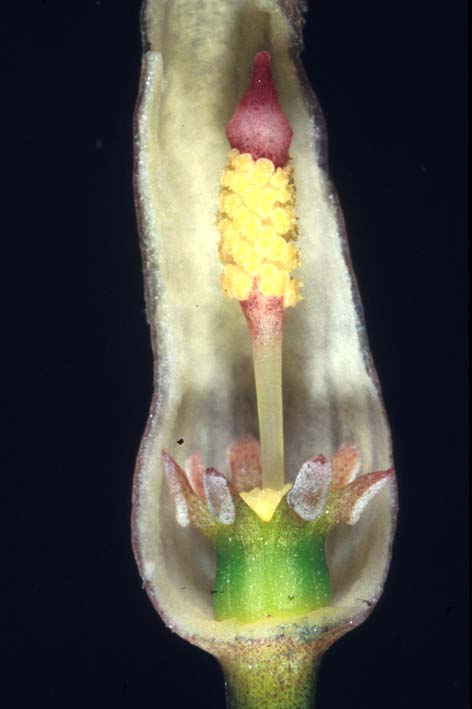 |
Another kettle of the 'Morco' plant to see the
variation in one form.
coll.Morco, cult. B756
photo van Bruggen |
|
| |
|
|
|
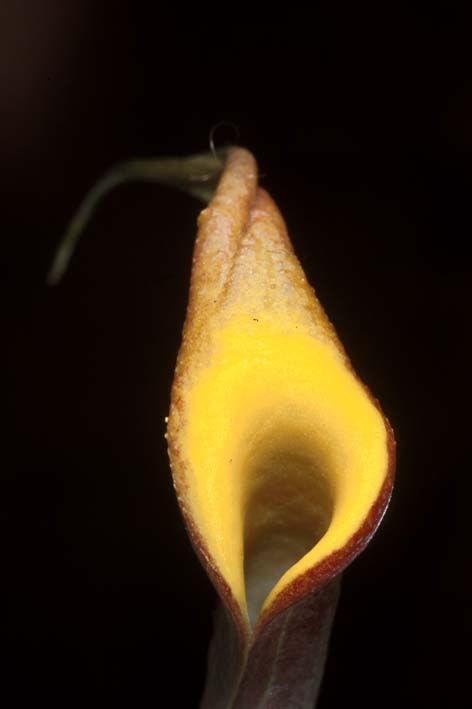 |
The limb of the spathe of the 'Christensen'
plant with a slight brown limb of the spathe.
coll. hort. cult, B755 (=NJ 2116) |
|
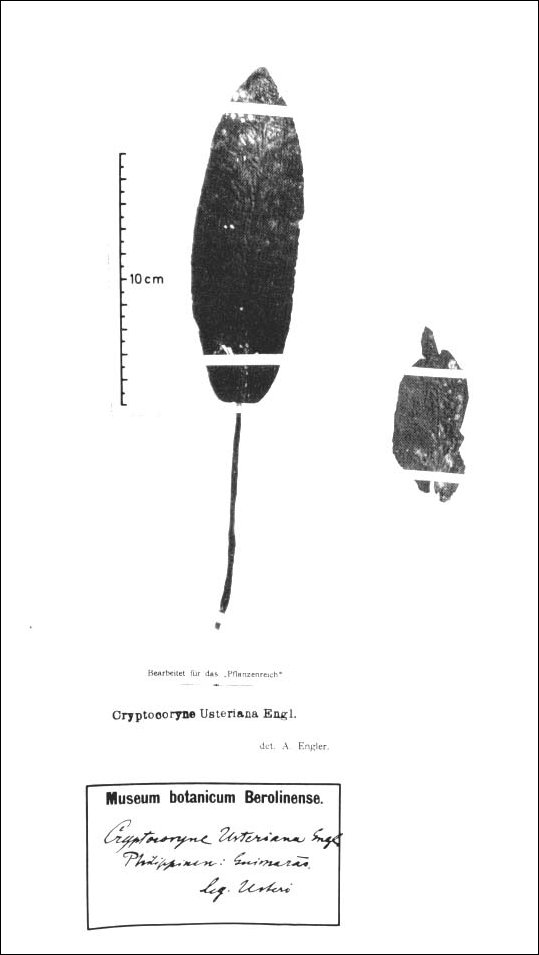 |
Part of the herbarium sheet of C. usteriana at Berlin. This is the type, collected by Usteri in 1903 and described by Engler (1905).
coll. Usteri 965
photo K. Liedl
|
|
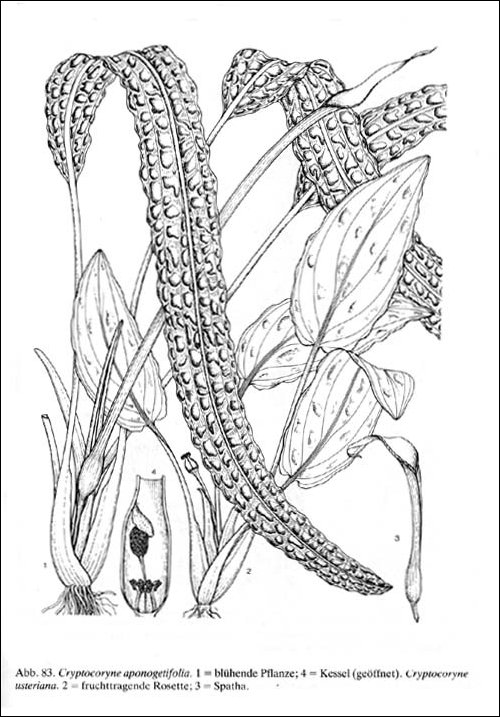 |
De Wit (1990) joined drawings of C.
aponogetifolia (the linear leafed plant at left) and C. usteriana (ovate
leaves at right) together in one picture. Until 1983 (before the famous collection of
Bogner) most botanist believed both species were identical. De Wit doubted 30 years, and
it turned out he was alright.
drawing Ike Zewald |
|
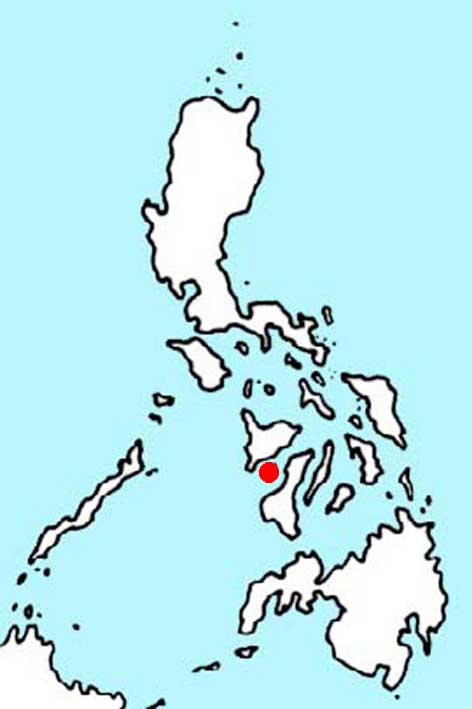 |
C. usteriana is known from the small
island Guimaras, SW of Panay island in the Philippines (enclosed in the red circle).
Localities on Panay island (where also C. aponogetifolia is (was?) to be found?)
and Cebu island are not fully certain. |
|
| |
|
|
|
A short usteriana story. For decades there was the opinion that C. aponogetifolia and C. usteriana were
synonyms, see the arguments in de Wit (1990). De Wit always kept his doubt on this. In
1983, Josef Bogner from Botanical Gardens Munich, collected a tiny plant on the Guimaras
isle (Philippines). When it flowered at Möhlmann, it proved the
identity of Cryptocoryne usteriana and Cryptocoryne aponogetifolia as
two different species. Later collections (named here Bednii, Christensen and Morco) showed
that there is some variation in the species. Another C. usteriana found by
Christensen from Panay is not in cultivation. See for comparison the table below (rather
arbitrarily). The data refer to emersed cultivated specimen.
|
max leaf width (cm) |
lower leaf color red |
limb brown |
spatha length (cm) |
| Bogner |
5 |
+/- |
- |
8 |
| Bednii |
8 |
+/- |
+/- |
15 |
| Christensen |
8 |
+/- |
+ |
15 |
| Morco |
8 |
+ |
+ |
8 |
Cryptocoryne usteriana is a good aquarium plant. The plant is very easy to
cultivate and can be obtained from any hobby club once established.
Other Cryptocoryne plants which have long bullate leaves are C. bullosa, C. hudoroi, C. keei, C. crispatula var. balansae and to some extend, some forms of C. affinis. The newly described C. coronata is a very lookalike to C. usteriana.
Updated December 2001 |
Literature.
- Bogner, J., 1984. Cryptocoryne usteriana Engler und Cryptocoryne
aponogetifolia Merrill. Aqua-Planta 4-84 : 7-13
- Bogner, J. & Jacobsen, N., 1984. Eine unbekannte Cryptocoryne aus Vietnam. Aqua-Planta
3-84 : 19-20.
- Engler, A., 1905. in: A.Usteri, Beitrage zur Kenntnis der Philippinen und ihrer
Vergetation, mit Ausblicken auf Nachbargebiete. Vjschr.Naturf.Ges.Zürich 50 : 452-453.
- Engler, A., 1916. Cryptocoryne usteriana Engler n.sp. Bot.Jb. 54, Beiblatt z d Bot. Jb.,
Nr 118 : 125
- Engler, A., 1920. (Cryptocoryne, Lagenandra in) Das Pflanzenreich IV.23.F. Araceae -
Aroideae : 232-249, Leipzig.
- Jacobsen, N., 1985. Cryptocoryne usteriana Engler. Aqua-Planta 4-85 : 14.
- Jacobsen, N., Bogner, J. & Christensen, C., 1998. Weitere Aufsammlungen von
Cryptocoryne usteriana Engler auf den Philippinen. Aqua Planta 3-98 : 113-115.
- Kasselmann, C., 1995. Aquarienpflanzen. Ulmer, Stuttgart.
- Merrill, E.D., 1925. Cryptocoryne. An Enumeration of Philippine Flowering Plants 1 : 189.
- Möhlmann, F., 1984. Kulturhinweise zu Cryptocoryne usteriana. Aqua-Planta 4-84 :14.
- Wit, H.C.D.de, 1990. Aquarienpflanzen, 2. Auflage. Ulmer, Stuttgart.
|
|
|
|
 |
|
|